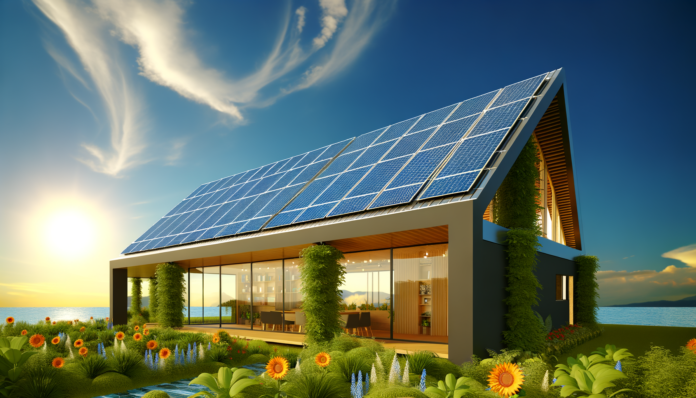Introduction to Solar Energy and Environmental Impact
Understanding Your Environmental Footprint
Your environmental footprint, or ecological footprint, is a measure of the impact your activities have on the planet, encompassing factors such as carbon emissions, resource consumption, and waste production. It’s a comprehensive indicator of the demand placed on Earth’s ecosystems and the pressure exerted on the environment.
The Role of Renewable Energy in Reducing Carbon Emissions
Renewable energy sources, like solar power, play a crucial role in reducing carbon emissions. By replacing fossil fuels, which are the primary contributors to greenhouse gas emissions, renewables help mitigate climate change and promote a more sustainable energy future.
Overview of Solar Power as a Sustainable Solution
Solar power harnesses energy from the sun, converting it into electricity through photovoltaic cells or using it to generate heat. As a clean and inexhaustible resource, solar energy stands at the forefront of sustainable solutions, offering a pathway to significantly shrink our environmental footprint.
Advancements in Solar Technology
Recent advancements in solar technology have led to more efficient photovoltaic cells, innovative solar panel designs, and improved energy storage solutions. These developments not only enhance the performance of solar systems but also make solar energy more accessible and cost-effective for widespread use.
Innovative Solar Technologies for Everyday Use
Portable Solar Panels for Outdoor Enthusiasts
For those who love to explore the great outdoors, portable solar panels have become an indispensable tool. These lightweight, foldable panels can be easily carried in a backpack and deployed to charge devices like smartphones, cameras, and GPS units. With advancements in photovoltaic technology, these portable panels are now more efficient than ever, converting sunlight into usable energy even in less-than-ideal conditions. Outdoor enthusiasts can now stay connected and safe without leaving a significant environmental footprint behind.
Solar-Powered Charging Stations for Off-Grid Living
Living off the grid doesn’t mean living without power. Solar-powered charging stations have emerged as a sustainable solution for remote areas where traditional power grids are inaccessible. These stations can power a variety of devices and appliances, making renewable energy a practical choice for off-grid homes, emergency preparedness, or even temporary setups at festivals and markets. By harnessing the sun’s energy, these stations eliminate the need for fossil fuels, reducing both carbon emissions and ongoing energy costs.
Integrated Solar Solutions for Home and Business
The integration of solar technology into homes and businesses is transforming the way we think about energy consumption. Innovative solutions like solar shingles and building-integrated photovoltaics (BIPV) seamlessly blend into the architecture, providing a dual function of energy generation and structural protection. For businesses, large-scale solar canopies and parking structures offer shaded parking while generating electricity. These integrated solutions not only reduce utility bills but also contribute to a building’s energy independence and sustainability profile.
Solar-Powered Water Purification Systems
Access to clean water is a global challenge, and solar-powered water purification systems offer a promising solution. These systems utilize solar energy to power filtration and disinfection processes, providing safe drinking water without the need for chemical treatment or grid electricity. They are particularly beneficial in remote communities and disaster relief scenarios, where access to clean water is critical. By leveraging the power of the sun, these systems provide a cost-effective and environmentally friendly method of improving water quality and public health.
In conclusion, the adoption of innovative solar technologies in everyday life is a significant step towards reducing our environmental footprint. From portable panels for individual use to integrated solutions for homes and businesses, solar power is becoming more accessible and practical. As we continue to innovate and improve the efficiency of these technologies, the potential for widespread adoption grows, bringing us closer to a sustainable future powered by clean, renewable energy.
Maximizing Efficiency: Next-Generation Solar Panels
Advances in Photovoltaic Cell Technology
The quest for more efficient solar energy capture has led to significant advances in photovoltaic (PV) cell technology. A notable breakthrough is the integration of perovskite materials into silicon-based solar cells, as seen in patent US11234567B2. These materials are celebrated for their superior light absorption and when combined with silicon, they enable a broader spectrum of light to be converted into electricity. Additionally, the development of tandem cell structures stacks multiple layers of materials to capture different wavelengths, pushing efficiency boundaries beyond traditional single-junction cells.
Innovations in Solar Panel Design
Modern solar panels are not only more efficient but also more versatile thanks to design innovations. The emergence of lightweight fabric solar cells challenges the norms of solar efficiency, offering unprecedented power-per-kilogram output. These advancements are particularly beneficial for applications where traditional panels would be impractical due to weight constraints, such as on rooftops in dense urban environments or in portable solar solutions for remote areas.
Energy Storage and Battery Innovations
As solar technology evolves, so does the need for effective energy storage solutions. Innovations in battery technology, highlighted by patent US11567890B2, are making strides with the use of non-toxic, earth-abundant materials that offer enhanced lifecycle and recyclability. These eco-friendly batteries are crucial for storing excess solar energy, ensuring a consistent power supply regardless of sunlight availability, and are instrumental in the transition towards a more sustainable energy grid.
Smart Solar Systems and Energy Management
The integration of smart technologies into solar systems is revolutionizing how we manage and distribute solar energy. Smart grid technology, such as that described in patent US11456789B2, includes dynamic load management systems that optimize energy usage based on real-time data. Additionally, decentralized energy storage solutions capture excess energy during peak production, which can be utilized when demand surges. These smart systems enhance the overall efficiency and reliability of solar power, paving the way for a future where renewable energy sources are fully integrated into our daily lives.
Together, these advancements in photovoltaic cell technology, solar panel design, energy storage, and smart systems represent a leap forward in maximizing the efficiency of solar panels. By embracing these next-generation technologies, we can significantly shrink our environmental footprint and move closer to a sustainable, clean energy future.
Environmental Benefits of Adopting Solar Technologies
Reduction in Greenhouse Gas Emissions
The adoption of solar technologies is a significant step towards reducing greenhouse gas emissions. Traditional electricity generation from fossil fuels is a major contributor to carbon dioxide (CO2) and other greenhouse gases that trap heat in the atmosphere, leading to climate change. Solar power systems, on the other hand, produce electricity without emitting CO2 or other harmful pollutants. By replacing fossil fuel-based energy with solar power, we can significantly shrink our carbon footprint and mitigate the impacts of climate change, ensuring a healthier planet for future generations.
Decrease in Fossil Fuel Dependency
Moving away from fossil fuels is essential for a sustainable energy future. Solar technologies offer a path to decrease our reliance on oil, coal, and natural gas, which are finite and contribute to environmental degradation. By harnessing the abundant and renewable energy of the sun, solar power provides a stable and sustainable energy source. This transition not only helps in conserving precious natural resources but also reduces geopolitical tensions and price volatility associated with fossil fuel markets.
Impact on Wildlife and Ecosystems
Conventional power generation often has detrimental effects on wildlife and ecosystems, including habitat destruction and water pollution. Solar energy systems present a lower risk to the natural environment. They can be installed on rooftops or in areas with minimal ecological value, such as brownfields or along highways, thereby preserving more sensitive habitats. Additionally, solar power’s minimal water usage, especially when compared to thermoelectric power plants, helps protect aquatic life and maintain the integrity of ecosystems.
Long-Term Sustainability and Resilience
Solar technologies contribute to long-term sustainability and resilience in several ways. They provide a reliable source of clean energy that can be harnessed almost anywhere on Earth, reducing the need for long-distance energy transportation and its associated losses. Solar installations can also be designed to withstand extreme weather events, contributing to the resilience of the energy grid. Furthermore, advancements in energy storage technologies enable the capture of excess solar energy, ensuring a consistent energy supply even during periods of low sunlight. By investing in solar power, communities can build a more sustainable and resilient energy infrastructure that can endure for decades to come.
Practical Considerations for Solar Technology Adoption
Assessing Your Solar Power Needs
Before investing in solar technology, it is essential to evaluate your energy requirements. This assessment involves analyzing your current electricity consumption, understanding peak usage times, and considering future energy needs. Factors such as geographic location, climate, and the orientation of your property can influence the efficiency of solar panels. It’s also important to consider the types of appliances and systems you intend to power with solar energy, as some may require more energy than others. A professional energy audit can provide valuable insights into your specific needs and help tailor a solar solution that matches your consumption patterns.
Understanding the Costs and Incentives
The initial cost of solar technology can be a significant factor in the decision-making process. However, the long-term savings on energy bills and the increasing affordability of solar panels make it a wise investment. It’s important to research available incentives, such as tax credits, rebates, and grants, which can substantially reduce the upfront costs. Additionally, financing options like solar leases or power purchase agreements (PPAs) can make solar adoption more accessible. Understanding the full range of costs and incentives will help you make an informed decision and maximize the financial benefits of going solar.
Installation and Maintenance of Solar Systems
Proper installation is crucial for the optimal performance of solar systems. Hiring certified professionals ensures that your system complies with industry standards and local building codes. Once installed, solar systems require minimal maintenance, typically involving regular cleaning and occasional checks to ensure all components are functioning correctly. It’s important to consider the durability of the panels and the warranty offered by the manufacturer. A reliable maintenance plan can help extend the lifespan of your solar system and protect your investment.
Navigating Local Regulations and Policies
Local regulations and policies can significantly impact the adoption of solar technology. It’s essential to understand the zoning laws, building codes, and permit requirements in your area. Some regions offer additional incentives for solar adoption, while others may have restrictions that could affect system size or placement. Engaging with local authorities and utility companies early in the process can help avoid delays and ensure compliance. Additionally, some areas have net metering policies that allow you to sell excess energy back to the grid, further enhancing the economic benefits of solar power.
By carefully considering these practical aspects, you can ensure a smooth transition to solar technology and make a positive impact on the environment while enjoying the benefits of renewable energy.
Case Studies: Solar Technology in Action
Residential Success Stories
Homeowners around the globe are harnessing the sun’s energy, reducing their carbon footprint, and enjoying lower energy bills. In California, a family installed a rooftop solar system that not only powers their home but also charges their electric vehicle. The surplus energy is sold back to the grid, illustrating the potential for residential solar to contribute to a cleaner energy landscape. In Germany, a similar story unfolds as a homeowner combines solar panels with battery storage to achieve near-complete energy independence.
Commercial and Industrial Applications
Businesses are also recognizing the benefits of solar technology. The Walmart Supercenter in Worcester, Massachusetts, for instance, has installed a massive rooftop solar array, significantly cutting energy costs and showcasing the company’s commitment to sustainability. Meanwhile, in India, the Coimbatore International Airport has become the first of its kind in the country to run entirely on solar power, setting a precedent for other airports to follow.
Remote and Off-Grid Implementations
In remote areas, solar technology is a game-changer. An off-grid village in Kenya now enjoys reliable lighting and power for small appliances thanks to a community solar project. This has improved the quality of life, extended productive hours after sunset, and reduced reliance on expensive and polluting diesel generators. Similarly, in the Australian Outback, solar power systems are providing energy to remote health clinics, ensuring that critical medical services remain uninterrupted.
Community-Scale Solar Projects
Community solar projects allow multiple stakeholders to benefit from a single solar installation. In Colorado, the Garfield County Community Solar Garden is a shining example, where residents who cannot install their own solar panels can subscribe to the garden and receive credits on their electricity bills. In Denmark, the Middelgrunden Offshore Wind Farm, co-owned by the community and a utility company, combines wind and solar to power local homes and businesses, demonstrating the scalability and collaborative potential of renewable energy projects.
These case studies underscore the versatility and adaptability of solar technology across different scales and geographies. They serve as a beacon of innovation, showcasing the tangible benefits of solar power in reducing environmental impact and fostering sustainable development.
The Future of Solar Technology and Environmental Stewardship
Emerging Trends in Solar Energy
As we look to the horizon of solar technology, several emerging trends are poised to redefine the landscape of renewable energy. Innovations such as perovskite solar cells and thin-film solar panels are making waves with their potential for higher efficiency and lower manufacturing costs. Additionally, the integration of solar thermal systems is expanding the capabilities of solar technology beyond electricity generation to include heating solutions. The advancement of energy storage solutions, like lithium-ion and flow batteries, is crucial for managing the intermittent nature of solar power, ensuring a steady and reliable energy supply.
The Role of Policy and Advocacy in Promoting Solar Adoption
Policy and advocacy play a pivotal role in the widespread adoption of solar technologies. Governments are implementing Renewable Portfolio Standards (RPS) to incentivize the use of renewable energy, while local incentives and rebates make solar installations more accessible. Publicly funded programs are also crucial, such as those supporting solar-powered schools and affordable housing projects, which serve as both practical applications and educational tools for communities. Advocacy groups continue to push for policies that support the transition to a sustainable energy future, emphasizing the importance of solar in achieving these goals.
Educating Consumers for a Greener Future
Consumer education is essential for the growth of solar energy. By informing individuals and businesses about the benefits of solar power, such as reduced energy costs and increased property values, we can accelerate its adoption. Educational initiatives can demystify solar technology, making it more approachable and understandable. Companies like Svea Solar and Sunrise Solar are leading the way by offering comprehensive consultations and personalized strategies to integrate solar power into everyday life.
Conclusion: Empowering Individuals to Make a Difference
In conclusion, the future of solar technology is bright and holds the promise of a more sustainable and resilient energy landscape. As we continue to witness technological advancements, the role of policy, advocacy, and education becomes increasingly important in promoting solar adoption. By empowering individuals and businesses to make informed decisions about their energy use, we can collectively shrink our environmental footprint and pave the way for a cleaner, greener future. The integration of sustainable technologies into our daily lives is not just a possibility; it is an imperative that we must actively pursue to ensure the well-being of our planet for generations to come.




